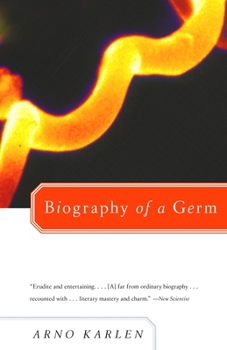Biography of a Germ
Select Format
Select Condition 
Book Overview
This is high drama played out on a very small stage: a microbe's life seen from its own point of view. The bacterium Borrelia burgdorferi (Bb for short) is a tiny, pale spiral, invisible to the naked... This description may be from another edition of this product.
Format:Paperback
Language:English
ISBN:0385720661
ISBN13:9780385720663
Release Date:May 2001
Publisher:Knopf Publishing Group
Length:192 Pages
Weight:0.50 lbs.
Dimensions:0.6" x 5.0" x 7.8"
Customer Reviews
5 ratings
An enjoyable look at a small subject
Published by Thriftbooks.com User , 21 years ago
Sometimes it's the simple books that help cut down the clutter and look at something in a manageable way. So often books about disease or germs become large dense tomes. Karlen has taken the time to look at a single germ, the one responsible for Lyme Disease, and looks at its past, present and potential future. Along the way he teaches you Biology 101 about germs in a simple and enjoyable manner. A simple book with a simple purpose, but one that shows us an aspect of the world around us we may not have thought about.
Microbiology as literature
Published by Thriftbooks.com User , 23 years ago
The germ is the bacterium Borrelia burgdorferi, and it causes among other things Lyme disease. Karlen is a psychoanalyst by trade and a historian of microbiology by inclination. He fell in love with the world of the very small when as a boy he was given a microscope. Karlen is also a fine prose stylist with a sharp sense of the ecological. In fact this book is really a kind of treatise on ecology, with a concentration on the environment of a bacterium. Borrelia burgdorferi is spread by ticks that bite small animals such as mice and squirrels and larger animals such as deer and sometimes humans. What Karlen accomplishes in this modest little book is to make vivid just what a "germ" is for a general readership. If you are in a fog about microbes and would like a painless, lively introduction, then this book may serve you very well.I always imagined that bacteria split about every twenty minutes. Here I learned that some bacteria do split every twenty minutes or so, but others take hours and some even longer. I was also fuzzy about just how it is that microbes cause disease. Do they "eat" human flesh or destroy our cells with toxins or hog our nutrients for themselves? Turns out that some do one thing and some do another. Karlen emphasizes that sometimes what they do is cause symptoms: fever, muscle aches, fatigue, inflamation, etc., which are actually the result of our immune system's aggressive response to the presence of something foreign. Sometimes this can get so out of hand that our immune system continues to attack our own cells even after the microbe is gone, as is suspected in rheumatoid arthritis and possibly fibromyalgia (p. 160). And sometimes microbes commandeer some part of our system in order to better spread themselves around by making us sneeze or cough (cold viruses) or by giving us diarrhea (cholera).There is a lot of other information in this little book, including such diverse facts as tumble weeds being native to southern Russia and not the western United States as I had always thought, or that the people of Lyme, Connecticut didn't appreciate having a disease named after their town. It is also interesting to know that microbes can "hide" in our bodies for years and then break out during times of overload or stress.Karlen digresses nicely in spots, giving his opinion on the Gaia concept (he likes the "original, narrower version" p. 63), and how he feels about the deer population in the U.S. (he thinks there are too many). This last is directly relevant since it is on the deer that the ticks that are the vectors for Lyme disease mate and are able to reproduce. He recalls some history (the cholera epidemics in London in the nineteenth century, Spanish flu in America, etc.) and literature (Defoe's Journal of the Plague Year; the anonymous The Autobiography of a Flea), and in a footnote (p. 29) cites a story by Isaac Babel about syphilis (a bacterium related to Borrelia burgdorferi) entitled "Guy de Maupassant." A
Amusing and Informative
Published by Thriftbooks.com User , 23 years ago
I have Lyme disease, and have read tons of info on Bb. This is the first description I've found that I would not describe as dry. There's an old saying that you should keep your friends close, but your enemies closer. This book allows you to do so with a germ that's wreaking havoc in your life in a way that makes you laugh instead of cry. I'm glad Arno Karlan wrote this book.
a cute little book
Published by Thriftbooks.com User , 23 years ago
This is a cute little book on science which is also very informative and easy to read at the same time. I highly recommend it to anyone who may be interested in biology, medicine, popular science, or just a good story well told, as it covers not just the life of the germ, but also a little bit of its cultural and natural history.
a little gem
Published by Thriftbooks.com User , 23 years ago
This is a slim book, simply written, easily read. But it also packs a lot of information between its pages--all that you need to know about Bb, the germ in question, in fact. It's also full of anecdotes, literary and cultural history, and even personal history. The short chapters make the book a very compelling read. Sure, this book isn't for scholars, but for the common readers who may not know much about the sciences. But I think it's all the better for it.




